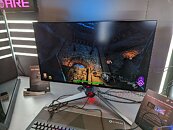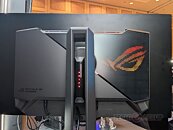- Joined
- Oct 9, 2007
- Messages
- 47,668 (7.43/day)
- Location
- Dublin, Ireland
| System Name | RBMK-1000 |
|---|---|
| Processor | AMD Ryzen 7 5700G |
| Motherboard | Gigabyte B550 AORUS Elite V2 |
| Cooling | DeepCool Gammax L240 V2 |
| Memory | 2x 16GB DDR4-3200 |
| Video Card(s) | Galax RTX 4070 Ti EX |
| Storage | Samsung 990 1TB |
| Display(s) | BenQ 1440p 60 Hz 27-inch |
| Case | Corsair Carbide 100R |
| Audio Device(s) | ASUS SupremeFX S1220A |
| Power Supply | Cooler Master MWE Gold 650W |
| Mouse | ASUS ROG Strix Impact |
| Keyboard | Gamdias Hermes E2 |
| Software | Windows 11 Pro |
It may be small, but it's fast! The new ROG Swift Pro PG248QP is a 24.1-inch planar gaming monitor with a measly Full HD (1920 x 1080 pixels) resolution, but an at an incredible 540 Hz refresh rate, making it the world's fastest E-Sports display. This display is so quick, and ASUS set up a 144 Hz display next to it for comparison, and one could tell the difference. The monitor also features NVIDIA G-SYNC, and NVIDIA Reflex Analyzer, along with a USB 3.2 hub, so you can plug your Reflex-compatible gaming mouse to the monitor, and the monitor itself to an upstream USB 3.2 source, besides the DisplayPort connection. Another interesting aspect about this monitor is that ASUS has integrated a high-end USB audio DAC sourced from ESS, so you can plug your analog headset to the display and get audio quality on par with a high-end onboard audio solution, or even a mid-range discrete sound card.
Elsewhere across the ASUS ROG booth, we caught the ASUS ROG Swift PG27AQDM-OLED, the company's fastest gaming monitors to use an OLED panel. This 27-inch monitor offers WQHD (2560 x 1440 pixels) resolution, with 0.03 ms response time, and 240 Hz refresh rate, besides 1,000 nits peak brightness, and 99% DCI-P3 coverage. The panel features an anti-glare micro-coating. OLED displays tend to produce more heat than backlit LCD displays, and so this monitor packs a series of thermal innovations to prolong the lifespan of the OLED panel. It supports AMD FreeSync Premium,



View at TechPowerUp Main Site
Elsewhere across the ASUS ROG booth, we caught the ASUS ROG Swift PG27AQDM-OLED, the company's fastest gaming monitors to use an OLED panel. This 27-inch monitor offers WQHD (2560 x 1440 pixels) resolution, with 0.03 ms response time, and 240 Hz refresh rate, besides 1,000 nits peak brightness, and 99% DCI-P3 coverage. The panel features an anti-glare micro-coating. OLED displays tend to produce more heat than backlit LCD displays, and so this monitor packs a series of thermal innovations to prolong the lifespan of the OLED panel. It supports AMD FreeSync Premium,



View at TechPowerUp Main Site






